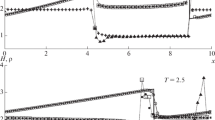Summary
An adaptive finite element method for the calculation of transonic potential flows was developed. A residual based error indicator is complemented by a shock indicator. For a good shock resolution mesh refinement as well as moving nodes were needed. An analysis of the method and computational results are given.
Similar content being viewed by others
References
Berger, H. (1989): A convergent finite element formulation for transonic flow. Numer. Math.56, 425–447
Berger, H. (1989): Finite-Element-Approximationen für transsonische Strömungen. PhD Thesis, Universität Stuttgart
Berger, H., Warnecke, G., Wendland, W.L. (1990): Finite elements for transonic potential flows. Num. Meth. PDE6, 17–42
Bers, L. (1954): Existence and uniqueness of subsonic flow past a given profile. Comm. Pure. Appl. Math.7, 441–504
Bojarski, B. (1967): Subsonic flow of compressible fluid. Mathematical Problems in Fluid Mechanics. Polish Academy of Sciences, Warsaw
Bristeau, M.O. (1977): Application of optimal control theory to transonic flow computations by finite element methods. In Proceedings of the Third INRIA Symposium on Computing Methods in Applied Sciences and Engineering. pp. 103–124, Versailles, France
Bristeau, M.O. (1980): Application of a finite element method to transonic flow problems using an optimal control approach. In: W., Kollmann, ed., Computational Fluid Dynamics. pp. 281–328, McGraw-Hill, New York
Bristeau, M.O., Glowinski, R., Periaux, J., Perrier, P., Pironneau, O. (1979): On the numerical solution of nonlinear problems in fluid dynamics by least squares and finite element methods I. Least squares formulations and conjugate gradient solution of the continuous problem. Comput. Methods Appl. Mech. Engrg.17/18, 619–657
Bristeau, M.O., Glowinski, R., Periaux, J., Perrier, P., Pironneau, O., Poirier, G. (1980): Application of optimal control and finite element methods to the calculation of transonic flows and incompressible flows. In: B. Hunt, ed., Numerical Methods in Applied Fluid Dynamics. pp. 203–312, Academic Press, New York
Bristeau, M.O., Glowinski, R., Periaux, J., Perrier, P., Pironneau, O., Poirier, G. (1982): Transonic flow simulations by finite elements and least squares methods. In: R.H. Gallagher, G. Carey, J.T. Oden, O.C. Zienkiewicz, eds., Finite Elements in Fluids vol. 4. pp. 453–482, Wiley, Chichester
Cavendish, J.C. (1974): Automatic triangulation of arbitrary planar domains for the finite element method. Int. J. Num. Meth. Eng.8, 679–696
Ciarlet, P.G. (1978): The Finite Element Method for Elliptic Problems. North-Holland, Amsterdam
Feistauer, M., Nečas, J. (1985): On the solvability of transonic potential flow problems. Z. Anal. Anw.4, 305–329
Feistauer, M., Nečas, J. (1988): Remarks on the solvability of transonic flow problems. Manuscripta Math.61, 417–428
Glowinski, R. (1984): Numerical Methods for Nonlinear Variational Problems. Springer, Berlin Heidelberg New York
Göhner, U. (1991): Adaptive Finite-Element-Methoden für transsonische Strömungen. PhD Thesis, Universität Stuttgart
Göhner, U. (1992): Adaptive finite element methods for transonic flows. (Manuscript)
Göhner, U., Warnecke, G. (1992): A second order difference error indicator for adaptive transonic flow computations. (Manuscript)
Göhner, U., Warnecke, G., Wendland, W. (1992): Error indicators for adaptive transonic flow computations. (Manuscript)
Keyfitz, B., Warnecke, G. (1991): The existence of viscous profiles and admissibility for transonic shocks. Commun. Part. Diff. Eqns.16, 1197–1221
Lo, S.H. (1985): A new mesh generation scheme for arbitrary planar domains. Int. J. Num. Meth. Eng.21, 1403–1426
Morawetz, C.S. (1985): On a weak solution for a transonic flow problem. Comm. Pure Appl. Math.38, 797–817
Nečas, J. (1967): Les Méthodes Directes en Théorie des Équations Elliptiques. Masson, Paris
Nečas, J. (1986): Introduction to the Theory of Nonlinear Elliptic Equations. Wiley, New York
Rannacher, R., Scott, R. (1982): Some optimal error estimates for piecewise linear finite element approximations. Math. Comput.38, 437–445
Author information
Authors and Affiliations
Additional information
The research reported in this article was supported by the Deutsche Forschungsgemeinschaft and the Volkswagen-Stiftung
Rights and permissions
About this article
Cite this article
Göhner, U., Warnecke, G. A shock indicator for adaptive transonic flow computations. Numer. Math. 66, 423–448 (1993). https://doi.org/10.1007/BF01385706
Received:
Revised:
Issue Date:
DOI: https://doi.org/10.1007/BF01385706




